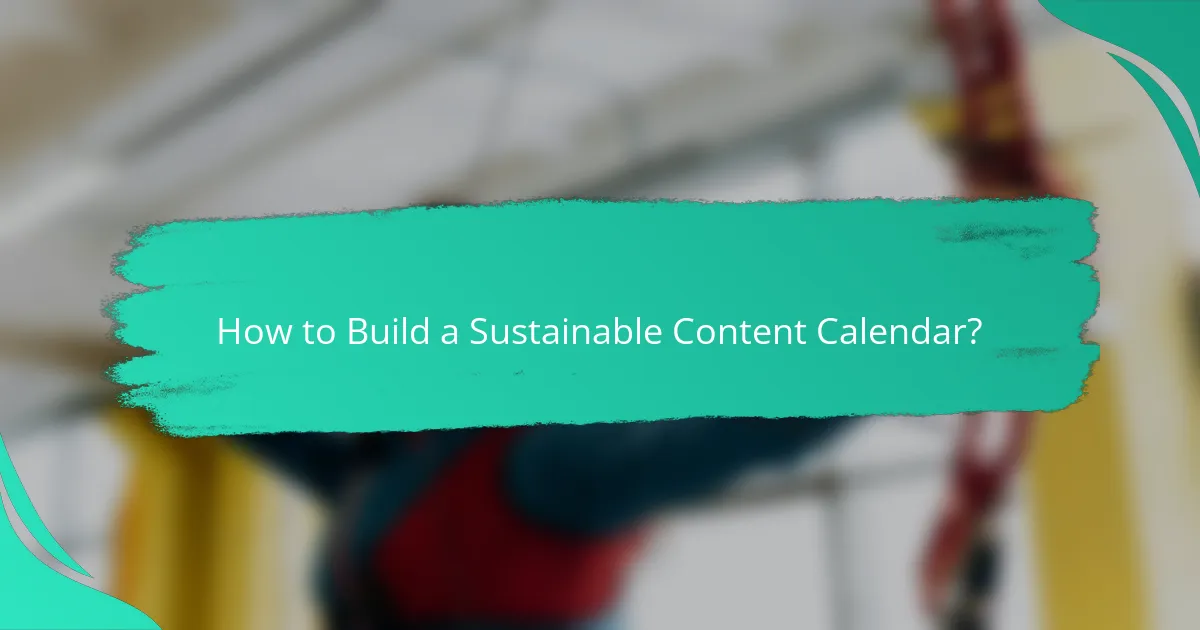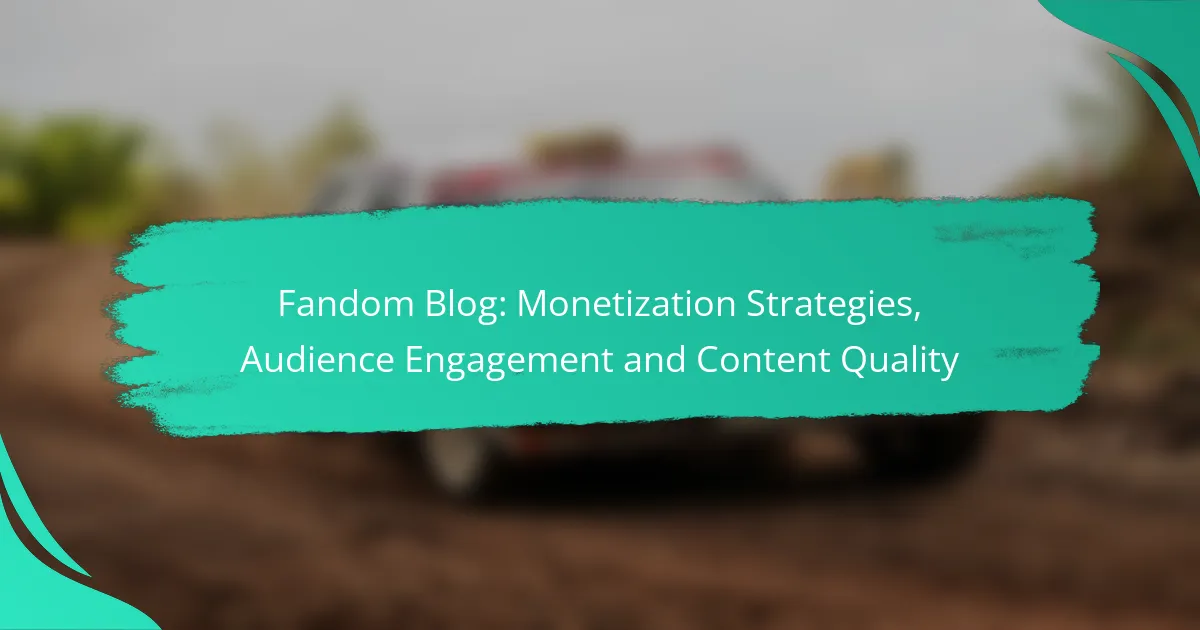In the vibrant world of fandom blogging, monetization strategies play a crucial role in transforming passion into profit. By employing techniques such as affiliate marketing, sponsored content, and merchandise sales, creators can effectively engage their audience while ensuring high-quality content that resonates with fans. Building strong connections through effective engagement not only enhances community loyalty but also opens up diverse monetization opportunities.

How to Monetize a Fandom Blog?
Monetizing a fandom blog involves leveraging your audience’s passion through various strategies that generate income. Key methods include affiliate marketing, sponsored content, merchandise sales, membership models, and ad revenue generation.
Affiliate Marketing Strategies
Affiliate marketing allows you to earn commissions by promoting products related to your fandom. You can join affiliate programs of brands that align with your blog’s theme and share unique links in your posts.
Consider using platforms like Amazon Associates or niche-specific affiliate networks. Aim for products that resonate with your audience to increase conversion rates.
Sponsored Content Opportunities
Sponsored content involves partnering with brands to create posts that promote their products or services. This can be a lucrative option if you have a sizable and engaged audience.
To attract sponsors, showcase your blog’s traffic and engagement metrics. Ensure that any sponsored content aligns with your audience’s interests to maintain authenticity.
Merchandise Sales
Creating and selling merchandise can be a direct way to monetize your fandom blog. This could include items like T-shirts, posters, or digital downloads that reflect your blog’s theme.
Utilize print-on-demand services to minimize upfront costs. Promote your merchandise through your blog and social media channels to reach your audience effectively.
Membership Models
Membership models offer exclusive content or perks to subscribers for a monthly fee. This could include access to behind-the-scenes content, early releases, or community forums.
Platforms like Patreon can facilitate this model. Ensure that the benefits are compelling enough to encourage sign-ups while maintaining a balance with your free content.
Ad Revenue Generation
Generating ad revenue involves displaying ads on your blog, typically through networks like Google AdSense. This method can provide passive income as your traffic grows.
Focus on optimizing ad placements for visibility without compromising user experience. Monitor your analytics to adjust strategies and maximize earnings based on audience engagement.

What Are Effective Audience Engagement Techniques?
Effective audience engagement techniques foster strong connections between content creators and their fans. These strategies enhance interaction, build community, and ultimately drive loyalty and monetization opportunities.
Social Media Interaction
Social media platforms are vital for engaging with your audience in real-time. Regularly posting updates, responding to comments, and sharing user-generated content can create a vibrant online presence. Aim for a consistent posting schedule, ideally several times a week, to keep your audience engaged.
Utilize features like polls, stories, and live Q&A sessions to encourage participation. This not only boosts interaction but also provides valuable insights into your audience’s preferences and interests.
Community Building through Forums
Creating dedicated forums or discussion boards allows fans to connect over shared interests. These platforms can facilitate deeper conversations and foster a sense of belonging among members. Consider using platforms like Discord or Reddit, where users can easily share ideas and feedback.
Encourage active participation by hosting themed discussions or contests. Recognizing and rewarding contributions can motivate members to engage more frequently, enhancing the overall community experience.
Live Events and Webinars
Live events and webinars offer unique opportunities for real-time interaction with your audience. These formats allow for direct engagement through Q&A sessions, polls, and discussions, making fans feel valued and heard. Plan events regularly, perhaps monthly or quarterly, to maintain interest.
Promote these events across your social media channels and email newsletters to maximize attendance. Consider offering exclusive content or incentives, such as discounts or giveaways, to encourage participation and enhance the perceived value of attending.

How to Ensure High Content Quality?
To ensure high content quality, focus on delivering valuable, engaging, and well-researched material that resonates with your audience. Consistency in quality not only builds trust but also fosters a loyal community around your fandom blog.
Content Planning and Strategy
Effective content planning involves outlining topics that align with your audience’s interests and current trends within the fandom. Create a content calendar to schedule posts, ensuring a balanced mix of evergreen content and timely updates.
Consider using analytics tools to identify which topics generate the most engagement. This data can guide your strategy, helping you prioritize content that resonates with your readers while keeping your blog fresh and relevant.
SEO Best Practices for Fandom Blogs
Implementing SEO best practices is crucial for increasing visibility and attracting traffic to your fandom blog. Start by conducting keyword research to identify terms your audience is searching for, and incorporate these naturally into your content.
Optimize on-page elements such as titles, headings, and meta descriptions. Aim for clear, descriptive titles that include primary keywords, and ensure your images have alt text that reflects the content. Regularly update older posts to keep them relevant and improve their search rankings.
Utilizing User-Generated Content
User-generated content (UGC) can significantly enhance your blog’s authenticity and engagement. Encourage your audience to share their fan art, stories, or reviews, and feature this content on your blog to foster community involvement.
Establish clear guidelines for submissions to ensure quality and relevance. Highlighting UGC not only provides fresh content but also strengthens the bond between you and your audience, making them feel valued and heard.

What Are the Key Metrics for Success?
Key metrics for success in fandom blogs include traffic, engagement, and revenue. These metrics help assess the effectiveness of content and strategies in attracting and retaining an audience while generating income.
Traffic Analysis Tools
Traffic analysis tools are essential for understanding how visitors interact with your blog. Popular options include Google Analytics, which provides insights into visitor demographics, behavior, and traffic sources. Using these tools, you can track metrics like page views, unique visitors, and session duration.
Consider setting benchmarks for your traffic metrics, such as aiming for a steady increase of 10-20% month-over-month. Regularly reviewing these analytics can help you identify trends and adjust your content strategy accordingly.
Engagement Rate Measurement
Engagement rate measurement evaluates how actively your audience interacts with your content. This can be calculated through likes, shares, comments, and time spent on the page. A higher engagement rate often indicates that your content resonates well with your audience.
To improve engagement, focus on creating high-quality, relatable content that encourages interaction. Aim for an engagement rate of 1-5% as a general benchmark, but remember that niche audiences may have different standards.
Revenue Tracking Methods
Revenue tracking methods are vital for assessing the financial success of your blog. Common methods include tracking affiliate marketing earnings, ad revenue, and merchandise sales. Tools like Google AdSense and affiliate dashboards can provide detailed insights into your income streams.
Establish a monthly review process to analyze revenue trends and identify which strategies yield the best results. Setting clear financial goals, such as increasing revenue by 15-25% annually, can help guide your monetization efforts effectively.

What Are the Prerequisites for Starting a Fandom Blog?
To start a fandom blog, you need a clear understanding of your niche, knowledge of your audience, and the necessary technical setup. These prerequisites will help you create engaging content that resonates with fans and builds a loyal following.
Choosing a Niche
Selecting a niche is crucial for your fandom blog’s success. Focus on a specific area within a broader fandom, such as a particular genre, series, or character, to attract a dedicated audience. For example, instead of covering all of fantasy literature, you might concentrate on a specific book series or author.
Consider your personal interests and expertise when choosing a niche. This alignment will make content creation more enjoyable and sustainable. Research existing blogs to identify gaps in content that you can fill, ensuring your blog stands out.
Understanding Your Audience
Knowing your audience is key to creating relevant and engaging content. Identify who your readers are, their interests, and what they seek from your blog. Use social media platforms and fandom forums to gather insights about their preferences and behaviors.
Engage with your audience through polls, comments, and social media interactions. This feedback will help you tailor your content to meet their needs and foster a sense of community around your blog.
Technical Setup Requirements
Setting up your blog requires a few technical steps. First, choose a blogging platform that suits your needs, such as WordPress, Blogger, or Wix. Ensure the platform offers customization options and is user-friendly for both you and your audience.
Next, secure a domain name that reflects your niche and is easy to remember. Consider hosting options that provide good performance and reliability. Finally, familiarize yourself with basic SEO practices to enhance your blog’s visibility in search engines.

How to Build a Sustainable Content Calendar?
Building a sustainable content calendar involves planning and organizing your content creation to ensure consistency and relevance. A well-structured calendar helps maintain audience engagement while allowing for flexibility and adaptability in response to trends and feedback.
Identify Your Goals
Start by defining your primary objectives for content creation. Are you aiming to increase brand awareness, drive traffic, or boost engagement? Clear goals will guide your content choices and help measure success over time.
Consider using the SMART criteria—Specific, Measurable, Achievable, Relevant, Time-bound—to refine your goals. For example, instead of saying “increase followers,” aim for “gain 100 new followers on social media each month.”
Understand Your Audience
Knowing your audience is crucial for creating relevant content. Conduct surveys, analyze social media insights, and review engagement metrics to understand their preferences and interests.
Develop audience personas to visualize your target demographics. This can help tailor your content to meet their needs, ensuring higher engagement rates and fostering a loyal community.
Plan Content Types and Themes
Decide on the types of content you want to produce, such as blog posts, videos, podcasts, or social media updates. Diversifying content formats can cater to different audience preferences and increase reach.
Establish key themes or topics that align with your goals and audience interests. For instance, if your audience is interested in gaming, you might focus on game reviews, industry news, and tutorials.
Establish a Publishing Schedule
Create a realistic publishing schedule that balances frequency with quality. Aim for consistency, whether that means posting weekly, bi-weekly, or monthly, depending on your resources.
Use tools like Google Calendar or Trello to visualize your schedule. This can help you track deadlines and ensure a steady flow of content while allowing for adjustments as needed.
Monitor and Adjust
Regularly review your content performance using analytics tools to assess what resonates with your audience. Look for patterns in engagement, such as which topics generate the most interest or which formats perform best.
Be prepared to adjust your calendar based on these insights. If a particular theme is gaining traction, consider expanding on it or creating follow-up content to capitalize on audience interest.
